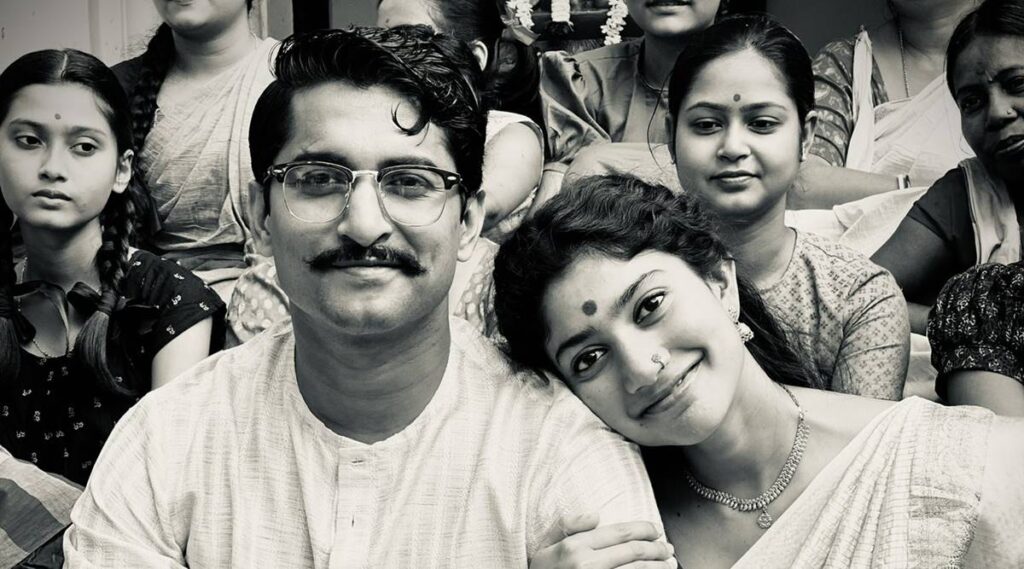What happens when South Indian cinematic brilliance collides with the poetic soul of Bengali literature? You get a masterpiece like Shyam Singha Roy. Directed by Rahul Sankrityan, this 2021 Telugu blockbuster is more than just a film—it’s an experience. With Nani in a dual role and Sai Pallavi’s spellbinding portrayal of a devadasi, this movie has captured hearts while seamlessly blending two rich cultural worlds. So, let’s dive deeper into how Shyam Singha Roy merges South Indian filmmaking finesse with Bengali literary grandeur.
Table of Contents
A Tale of Two Worlds
The story of Shyam Singha Roy alternates between two timelines, set in the present day and the 1960s. In the contemporary setting, Vasu, an aspiring filmmaker, struggles to make a name for himself. But when his script unexpectedly thrusts him into a legal battle, it unravels the life of Shyam Singha Roy, a revolutionary Bengali writer from decades ago.
This dual narrative gives the film its edge. Through Vasu and Shyam’s parallel lives, the movie connects South Indian and Bengali cultures, showcasing the universality of struggles, passions, and revolutions. It’s not just storytelling; it’s a bridge between two worlds, each steeped in its own traditions, yet surprisingly similar in their essence.
The Devadasi System: A Historical Reflection
One of the standout aspects of Shyam Singha Roy is its sensitive portrayal of the devadasi system. The film delves into the life of Maithri (played by Sai Pallavi), a devadasi whose art and identity are tied to temple rituals. Historically, devadasis were revered for their dedication to temples and their mastery of dance and music. However, over time, societal shifts led to their marginalization and exploitation.

Sai Pallavi’s performance is a revelation, bringing out the grace and tragedy of Maithri’s character. Her dance sequences, especially the one in the red saree, are pure poetry in motion. More than just a visual delight, her portrayal raises important questions about tradition, exploitation, and the price of cultural legacy.
The film doesn’t shy away from addressing the darker aspects of the devadasi system. It reflects the pain and resilience of women trapped in an archaic tradition, while also highlighting the beauty of their art. This balance of critique and celebration adds depth to the narrative, making it both thought-provoking and emotionally resonant.
Cultural Fusion at Its Best
Shyam Singha Roy is a visual feast, paying homage to the aesthetics of both South India and Bengal. From the grandeur of temple rituals to the serene beauty of Bengal’s lush landscapes, the film’s art direction and cinematography transport the audience to another era. The costumes, too, deserve a mention—Sai Pallavi’s traditional Bengali attire, complete with gold jewelry, is nothing short of iconic.
The film’s music, composed by Mickey J Meyer, blends classical Indian sounds with a touch of modernity. The soulful melodies not only enhance the emotional beats of the story but also capture the essence of two vibrant cultures. This fusion of South Indian and Bengali artistic elements makes Shyam Singha Roy a unique cinematic experience.
A Revolutionary Spirit
Shyam Singha Roy, the character, is not just a writer but a revolutionary. He uses his pen as a weapon to fight societal norms and injustices. His love for Maithri, a devadasi, defies the rigid class and caste systems of the time. This romantic yet rebellious streak makes him an unforgettable character. Nani’s performance brings out the intensity, vulnerability, and charm of Shyam with finesse.
The film also subtly critiques societal expectations, questioning outdated practices and highlighting the need for reform. It’s a story of love, rebellion, and hope—one that resonates deeply with today’s audience.
Critical Acclaim and Audience Love
While critics have appreciated the film’s performances and production design, some felt the screenplay could’ve been sharper. Nevertheless, Shyam Singha Roy has struck a chord with audiences, becoming one of the most talked-about films of the year. From its gripping narrative to its stunning visuals, the film offers a little something for everyone.
Conclusion
Shyam Singha Roy is not just a film; it’s a cultural dialogue. It reminds us of the power of storytelling to transcend boundaries and bring people together. Whether you’re a fan of South Indian cinema, Bengali literature, or just love a good story, this movie is a must-watch.
Want more insights into the magic of South Indian films? Dive into our exclusive articles on the latest trends, iconic actors, and timeless classics. Don’t miss out—click through and explore the vibrant world of South Indian entertainment today! Read here.






